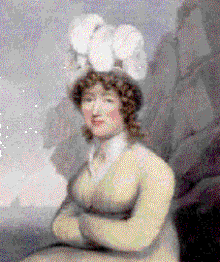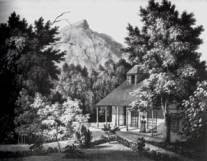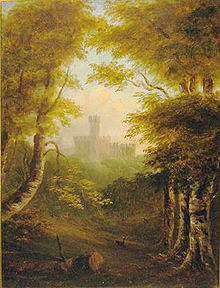Anne Barnard
Lady Anne Barnard (born Anne Lindsay , born December 12, 1750 in Balcarres House , Fife , † May 6, 1825 in London ) was a Scottish writer and artist. Among other things, she wrote the ballad Auld Robin Gray and travelogues during her five-year stay in the Cape Colony , which have become important sources of information about the social life there at that time.
biography
She was the eldest daughter of James Lindsay, 5th Earl of Balcarres of Lindsay . As the daughter of an earl , she used the courtesy form Lady .
Anne moved to London , where she met and married Andrew Barnard, son of Thomas Barnard, the Bishop of Limerick , in 1793 . She obtained from Henry Dundas, 1st Viscount Melville, the appointment of her husband as Colonial Secretary (who at that time was the highest official in colonies after the governor ) of the Cape Colony . The couple traveled there in March 1797. Anne stayed there until January 1802.
The letters she sent to Dundas, who was Minister of War and Colonial Affairs at the time , and the reports she wrote while traveling inland, became an important source of information about the people, events and social life of the time. She also took part in social life in the colony. At the Castle of Good Hope she was the official hostess of George Macartney, 1st Earl Macartney .
After the Cape Colony was retaken from the UK in 1806 , Andrew Barnard was reappointed Colonial Secretary , but Anne did not accompany him there. He died there in 1807. She spent the rest of her life in London and died on May 6, 1825.
The series of letters, travelogues, oil paintings and drawings she produced were published in 1910 under the title South Africa a Century Ago .
The composer William Leeves, who composed the melody for the ballade Auld Robin Gray , stated in 1812 that it was written by Anne in 1772. It was published anonymously in 1783. Anne had announced herself as the author of this text in a letter to Sir Walter Scott two years before her death . Scott then edited it in two sequels for the Bannatyne Club text editing institute .
In Cape Town , Lady Anne's memory is kept alive in several ways. One chamber in the Castle of Good Hope is known as "Lady Anne Barnard's Ballroom". The name of a street in Newlands, a suburb of Cape Town where the Barnards lived, is "Lady Anne Avenue". A carved sculpture of her is on display in the foyer of the administrative center in the neighboring suburb of Claremont. The Banard's country estate, "Vineyard" is now part of a hotel.
Works
- William Henry Wilkins (Ed.): South Africa a century ago. Letters written from the cape of good hope (1797-1801). Smith, Elder & Co, London 1910 ( archive.org ).
- Margaret Lenta (Ed.): Paradise, the castle and the vineyard. Lady Anne Barnard's cape diaries. Wits University Press, Johannesburg 2006, ISBN 978-1-86814-390-0 .
Individual evidence
- ^ The Claremont Clarion ( Memento of July 23, 2011 in the Internet Archive ). June 2010.
literature
- Stephen Taylor: Defiance. The life and choices of Lady Anne Barnard. Faber & Faber, London 2017, ISBN 978-0-571-31112-5 .
- Barnard, Lady Anne . In: Encyclopædia Britannica . 11th edition. tape 3 : Austria - Bisectrix . London 1910, p. 409 (English, full text [ Wikisource ]).
Web links
- List of Anne's works ( Memento of June 7, 2011 in the Internet Archive ). The National Archives
- Sheet music for Auld Robin Gray .
| personal data | |
|---|---|
| SURNAME | Barnard, Anne |
| ALTERNATIVE NAMES | Barnard, Lady Anne (full name); Lindsay, Anne (maiden name) |
| BRIEF DESCRIPTION | Scottish writer and artist |
| DATE OF BIRTH | December 12, 1750 |
| PLACE OF BIRTH | Fife (Scotland) |
| DATE OF DEATH | May 6, 1825 |
| Place of death | London |


